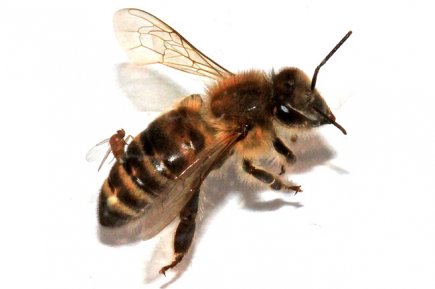The nation’s already hard-hit honeybees are now contending with a parasitic behavior-altering insect. The tiny fly Apocephalus borealis has been afflicting honeybees in the western United States since it was first documented in California in 2008. The pest first appeared in the Northeast last year, according to Ben Gittleson of ABC News.
A. borealis turns bees into real-life zombies — living dead creatures unable to control their own bodies.
“They fly around in a disoriented way, get attracted to light and then fall down and wander around in a way that’s sort of reminiscent of zombies in the movies,” John Hafernik, a professor of biology at San Francisco State University, told ABC News. “We’ve taken to calling [it] … ‘the flight of the living dead.’”
The parasite works its infestation by latching onto bees and depositing its eggs in the hosts’ bodies. A honeybee infected with the parasitic eggs will begin to act erratically, flying at night (an uncommon behavior) and seeking out lights in a disoriented manner. When the young A. borealis pupae hatch, the bee’s life expectancy drops to about five minutes.
Hafernik described the infestation as “sort of a combination of zombies and aliens mixed together.” Honeybees are far from the only species to be afflicted with these bizarre symptoms: many parasites inflict mind-altering behaviours on their hosts — which are usually compelled to abandon their normal habitat and thereby ensure the spread of the parasite.
National Geographic’s Carl Zimmer explored the phenomenon of zombie-creating parasites last year. Ladybugs, he discovered, are susceptible to the parasitic wasp Dinocampus coccinellae, which also deposits an egg in its hapless host. After hatching, the wasp larva eats its way out of the ladybug, spins its cocoon on the host’s underside, and forces the host — through means still not fully understood — to protect it by lashing out at the approach of potential predators.
The parasitic fungus Ophiocordyceps spp. works an even more bizarre change in the urges of its host, the Amazonian ant. Spores target the ant’s brain, insidiously forcing the creature to abandon the safety of the forest floor and take to the trees. This suits the fungus just fine and dooms other ants to the same fate. When the host is filled with spores, it attaches itself to the tree before branches of the fungus grow out of its shell and drop more mind-altering spores on the ants below.
Researchers suggest that many of the parasites are able to afflict their victims’ minds by releasing specialized enzymes into the host brain. These enzymes are then able to stifle normal urges — such as the instinct to flee from danger or to hide during light hours — and encourage self-destructive ones. The use of the host is a highly sophisticated adaptation of the parasite.
In the case of the nation’s honeybees, Hafernik is not convinced the threat is as dire as it sounds. “We’re not making the case that this is the doomsday bug for bees,” he told Michael Hill of the Associated Press. But interest in the phenomenon led him to develop ZomBeeWatch.org (https://www.zombeewatch.org) with his colleagues — a website making use of citizen scientists’ observations to locate where infected bees have been documented.








